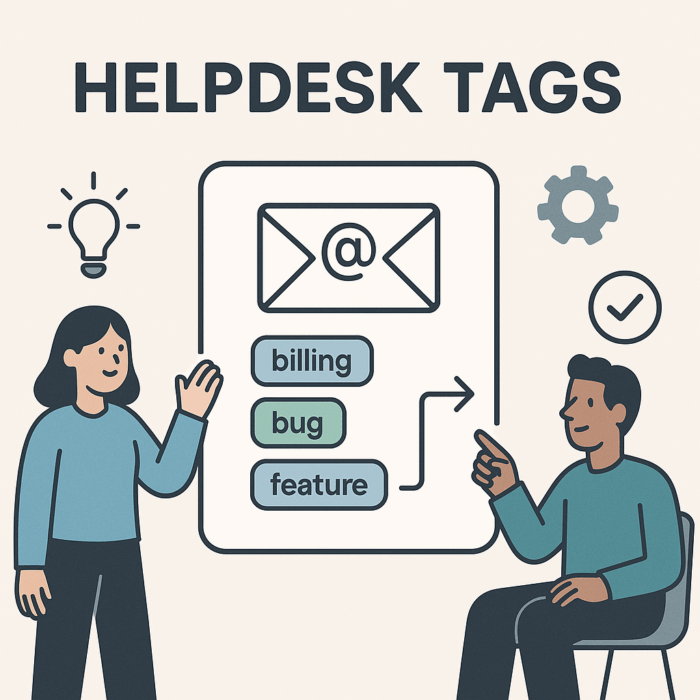Helpdesk tags are the fastest way to organize tickets without heavy configuration. Use them to route work, trigger responses, and surface trends. In this guide, you will set up helpdesk tags that keep triage clean, speed replies, and improve reporting.
What are helpdesk tags?
Tags are lightweight labels you add to tickets to describe the topic, status, or required action. They differ from categories and custom fields because tags are quick to apply, easy to search, and flexible. When used well, they become a shared language across support, product, and billing.
Ticket tags vs categories
- Tags are free form labels you can combine as needed.
- Categories are broader buckets like Product or Billing that you use for high level reporting.
- Use both together: a category for roll up visibility and tags for precise workflows.
Common mistakes with ad hoc tags
- Creating one off tags that overlap in meaning
- Using ambiguous names like
issueorfollowup - Letting anyone invent tags without review
For a deeper primer on tagging best practices, see the Nielsen Norman Group article on tagging.
Design a simple tag taxonomy
Start small. A clear starter set prevents tag sprawl and keeps training simple.
- Prefixes for clarity:
billing/,bug/,feature/,howto/,incident/,account/ - Process tags:
needs-info/,pending-vendor/,waiting-customer/,escalated/ - Outcome tags:
refund/approved,refund/denied,resolution/workaround
Prefix patterns that scale
Adopt a prefix plus topic format. For example:
billing/refundbug/loginfeature/ssoincident/outage-eu
This pattern keeps lists grouped and predictable in search results.
Retire and merge safely
Every quarter, export tag usage and merge near duplicates. Replace old tags on open tickets and update any rules that referenced them.
Governance: who creates and edits tags
Good governance keeps tags useful as the team grows.
- Owner: make a lead agent or team lead responsible for the taxonomy
- Request flow: agents propose a tag with a short reason and 2 sample uses
- Approval window: owner approves within 24 hours so work is not blocked
- Review cadence: quarterly clean up to remove, merge, or rename
A quick request process
- Check if a suitable tag already exists.
- If not, propose one with prefix and examples.
- Owner approves and adds to the list.
- Team is notified in the weekly standup note.
Tag driven workflows and triage rules
Tags shine when they automate your queue. For example, pair tags with triage rules to auto assign, set priority, and start escalations. If you are designing routing, use our guide to ticket triage rules.
Route incidents with incident/ tags
incident/outage-eu→ assign to on call, set priority to high, notify status channelincident/degraded-api→ assign to backend lead, add saved reply with status page link
Trigger saved replies from tags
Link a tag to a saved reply to reduce typing and keep tone consistent. See our saved replies templates.
Reporting with tags
Tags unlock actionable reporting without complex setup.
- Weekly trends: which tags spiked and why
- Aging by tag: which topics sit longest
- Root cause: which
bug/tags drive volume after each release
To choose the right KPI set, follow this overview of helpdesk metrics.
Build a lightweight dashboard
Track these 4 charts each week:
- Volume by top 10 tags
- Average first reply time by tag
- Escalations by
incident/tags - Backlog older than 7 days by tag
Examples: a practical starter tag set
Use or adapt this ready to go list.
Customer facing tags
billing/refund- Owner: Billing lead
- Action: Use refund path, apply policy, close with refund confirmation
howto/integration- Owner: Support lead
- Action: Send integration guide, link to docs, schedule a quick call if blocked
incident/outage-eu- Owner: On call engineer
- Action: Post status page link, update every 60 minutes until resolved
Internal process tags
needs-info/customer- Owner: Ticket assignee
- Action: Ask a single clear question and snooze 48 hours
pending-vendor/stripe- Owner: Billing lead
- Action: Open vendor ticket, update customer weekly
escalated/l2- Owner: L2 on call
- Action: Accept within 15 minutes and post next step in the ticket
For product specific implementations, vendor docs often include tag guidance. Zendesk explains how tags behave in automations in About tags. Help Scout covers tag filtering and workflows in Using tags.
Pitfalls to avoid
- Too many tags: cap the active list and deprecate rarely used ones
- Ambiguous names: prefer
billing/refundoverrefund - No training: agents guess and fragment your data
- No owner: tags drift and lose meaning over time
Run a 30 minute tag training
- Teach the prefix scheme with 5 examples
- Practice applying 10 tags to real tickets
- Review the request process and SLA
- Share the cheat sheet in your handbook
Implementation checklist
Follow this one page rollout plan for a 5 person team.
- Agree the taxonomy and assign an owner
- Create the tags in your helpdesk
- Map triage rules to
incident/,billing/, andbug/prefixes - Connect saved replies to common
howto/andbilling/questions - Publish the cheat sheet and run a short training
- Set up reports for trends, aging, and escalations
- Review after 2 weeks and merge duplicates
- Revisit quarterly so tags stay lean and accurate
If you are still setting up your tool stack, this day one guide will help you get a working helpdesk quickly: How to set up a helpdesk in one day. New agents can ramp faster with our helpdesk onboarding checklist. When you are ready to grow, compare costs on our pricing for small teams.
Conclusion
A small, consistent set of helpdesk tags creates order, speeds responses, and powers useful reports. Start with a clear prefix scheme, assign an owner, and connect tags to rules and replies. Review quarterly so tags stay simple as your team and product evolve.
Start your free 14 day trial to organize your inbox, automate triage, and respond faster with Support Oasis.
